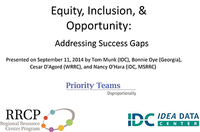Examples such as “Our state department of special education has identified my district as one that has disproportionate representation of black students in the ‘emotional disturbance’ category” represent a difference or “success gap” in educational outcomes among particular groups of students. Students who are members of racial, ethnic, or linguistic minority groups often face barriers and challenges in the educational system. When those challenges or barriers are not effectively or efficiently addressed, students may be identified as eligible for special education services when the real problem might be with the educational system rather than the unique learning challenges of an individual student. Racial/ethnic disproportionality in special education has been considered a longstanding problem across the United States, historically affecting minority students with regard to identification, educational environment, and discipline, leading to poorer outcomes for these groups of students.
In this webinar, which IDC staff presented for the University of Tennessee’s Boling Center for Developmental Disabilities, we first discuss the requirements in the IDEA related to disproportionality, describe methods for calculating disproportionality, and present data, both at the national level and for the state of Tennessee. The second part of the webinar introduces a research-based guidance document and self-assessment rubric designed to help schools and districts identify the root causes of "success gaps" for some groups of students, thereby helping to improve and equalize results for all students.
Presentation Slides
Resource Files & Links
Companion Resources
These are resources that supplement the resource above.
Format: Recordings
EMAPS IDEA Part C Child Count and Settings Survey WebinarOn Tuesday, February 23, 2016, OSEP, ESB, and PSC presented the EMAPS IDEA Part C Child Count and Settings Survey Webinar.
The purpose of this webinar was to review the procedures for submitting this survey, including the new cumulative counts for race/ethnicity and gender, new additional year-to-year rows, and change in the email notifications. The final slides are available to review here: https://edfacts.grads360.org/#communities/pdc/documents/10065
Related Content
Format: Presentations
Equity, Inclusion, and Opportunity: Addressing Success Gaps via the SSIP ProcessPresenters introduced a research-based guidance document and self-assessment rubric designed by OSEP's Disproportionality Priority Team to help districts and schools identify the root causes of "success gaps" for some groups of students, thereby helping to improve and equalize results for all students. As an example, presenters used Georgia's SSIP process, focused on graduation for students with disabilities.
Format: Guides and Briefs
Success Gaps Rubric: Addressing Equity, Inclusion, and OpportunityThis rubric allows a team of users from a district or school to systematically examine the root causes of success gaps among groups of students by focusing on equity, inclusion, and opportunity. The recently updated rubric now includes considerations for children as young as preschool age. A complementary white paper provided the research-based background that supported development of the rubric.
Format: Guides, Papers, and Reports
Equity, Inclusion, and Opportunity: Addressing Success Gaps, White PaperThis white paper focuses on elements of equity, inclusion, and opportunity that can minimize or eliminate success gaps among different groups of students. It provides the research-based background that guided development of a complementary rubric that schools or districts can use to systematically examine the root causes of success gaps among groups of their students. The white paper has been updated recently and now includes considerations for children as young as preschool.





